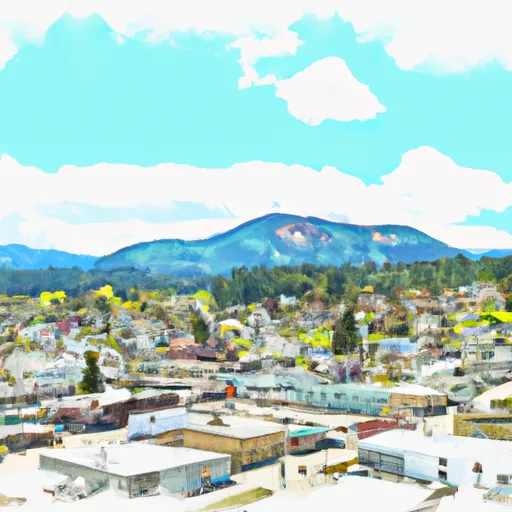-
 Snoflo Premium
Snoflo Premium
Get unlimited access to all our content
With no Ad interruptions! - Start Your Free Trial Login with existing account
North-Bonneville
Eden Index
Climate
6.0
•
Recreation
7.3
•
Community
•
Safeguard
5.0/10

North Bonneville is a small town located in Skamania County, Washington. The climate in North Bonneville is generally mild with warm summers and cool winters. The area is influenced by the Pacific Ocean, resulting in moderate rainfall throughout the year. The town is situated along the Columbia River, which provides a prominent hydrology feature. The river's flow is regulated by the Bonneville Dam, creating opportunities for boating, fishing, and other water activities. North Bonneville is surrounded by picturesque natural landscapes, including the nearby scenic Columbia River Gorge. This offers outdoor enthusiasts a variety of recreational opportunities such as hiking, camping, bird-watching, and wildlife viewing. With its stunning natural beauty and abundant outdoor activities, North Bonneville is a haven for nature lovers.
What is the Eden Index?
The Snoflo Eden Index serves as a comprehensive rating system for regions, evaluating their desirability through a holistic assessment of climate health, outdoor recreation opportunities, and natural disaster risk, acknowledging the profound impact of these factors on livability and well-being.
Climate Health Indicator (CHI): 6.0
North-Bonneville receives approximately
2038mm of rain per year,
with humidity levels near 82%
and air temperatures averaging around
12°C.
North-Bonneville has a plant hardyness factor of
8, meaning
plants and agriculture in this region tend to thrive here all year round.
By considering the ideal temperature range, reliable water supplies, clean air, and stable seasonal rain or snowpacks, the Climate Health Indicator (CHI) underscores the significance of a healthy climate as the foundation for quality living.
A healthy climate is paramount for ensuring a high quality of life and livability in a region, fostering both physical well-being and environmental harmony. This can be characterized by ideal temperatures, reliable access to water supplies, clean air, and consistent seasonal rain or snowpacks.
Weather Forecast
Streamflow Conditions
Lower Columbia
Area Rivers
Lower Columbia
Snowpack Depths
Lower Columbia
Reservoir Storage Capacity
Lower Columbia
Groundwater Levels
Recreational Opportunity Index (ROI): 7.3
The Recreational Opportunity Index (ROI) recognizes the value of outdoor recreational options, such as parks, hiking trails, camping sites, and fishing spots, while acknowledging that climate plays a pivotal role in ensuring the comfort and consistency of these experiences.
Access to outdoor recreational opportunities, encompassing activities such as parks, hiking, camping, and fishing, is crucial for overall well-being, and the climate plays a pivotal role in enabling and enhancing these experiences, ensuring that individuals can engage in nature-based activities comfortably and consistently.
Camping Areas
| Campground | Campsites | Reservations | Toilets | Showers | Elevation |
|---|---|---|---|---|---|
| Forlorn Lakes | 27 | 3,706 ft | |||
| Dougan Falls- State Forest | 7 | 692 ft | |||
| Port Authority - Cascade Locks Marine Park | 15 | 104 ft | |||
| Panther Creek | 41 | 940 ft | |||
| Wyeth - Columbia River Gorge Area | 13 | 159 ft | |||
| Goose Lake | 18 | 3,153 ft | |||
| Beaver | 44 | 1,059 ft | |||
| Govt. Mineral Springs | 5 | 1,258 ft | |||
| Paradise Creek | 50 | 1,571 ft | |||
| Home Valley Campground | None | 110 ft |
Nearby Ski Areas
Catastrophe Safeguard Index (CSI):
The Catastrophe Safeguard Index (CSI) recognizes that natural disaster risk, encompassing floods, fires, hurricanes, and tornadoes, can drastically affect safety and the overall appeal of an area.
The level of natural disaster risk in a region significantly affects safety and the overall livability, with climate change amplifying these risks by potentially increasing the frequency and intensity of events like floods, fires, hurricanes, and tornadoes, thereby posing substantial challenges to community resilience and well-being.
Community Resilience Indicator (CRI):
The Community Resilience Indicator (CRI) recognizes that education, healthcare, and socioeconomics are crucial to the well-being of a region. The CRI acknowledges the profound impact of these elements on residents' overall quality of life. By evaluating educational resources, healthcare accessibility, and economic inclusivity, the index captures the essential aspects that contribute to a thriving community, fostering resident satisfaction, equity, and social cohesion.

